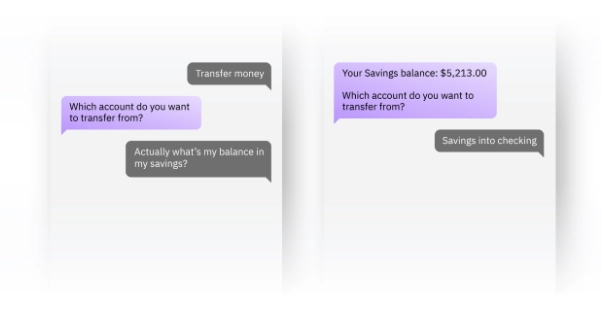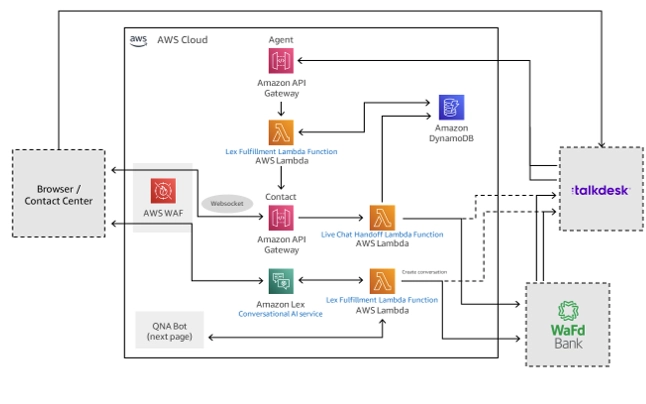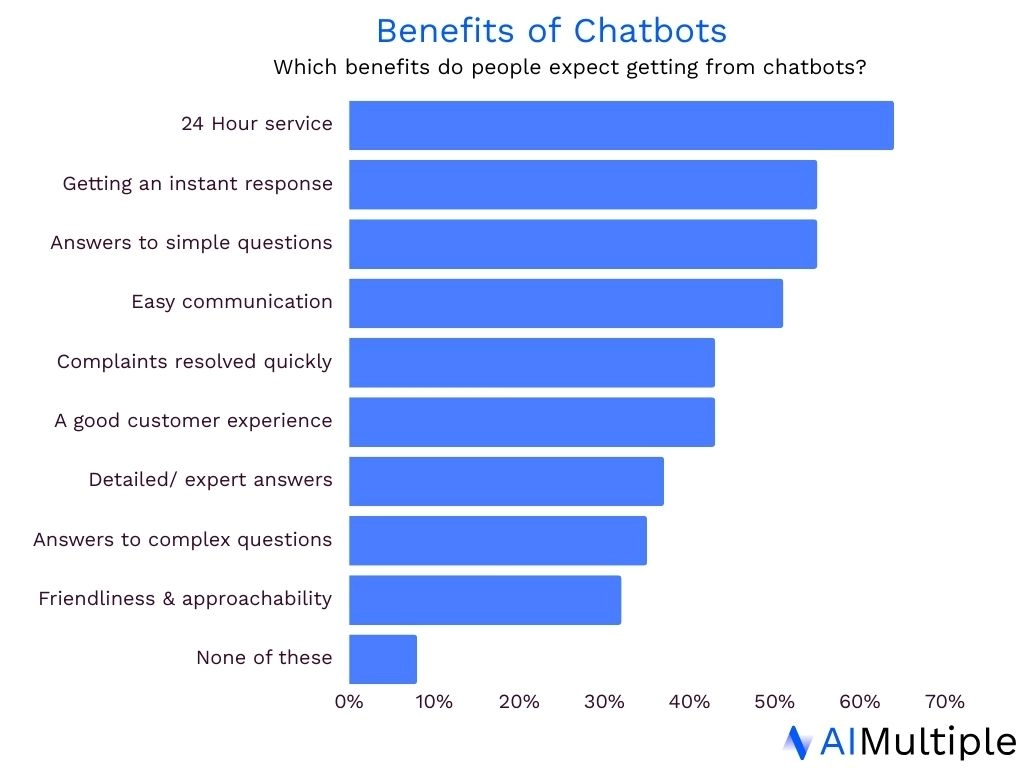Enterprises need scalable conversational customization to affordably delight their customers and manage a high volume of queries.
With over 200 conversational AI platforms available, choosing the right one can be challenging. Enterprises can find suitable solutions by focusing on key features, such as integrations with their existing tech stack, compatibility with their customers’ platforms, and customization options for customer communication.
We identified the top 10 solutions based on user reviews and included their key features and pricing.
Top 10 conversational AI platforms
| Vendor | Number of Employees | Avarage Score & Number of Reviews |
|---|---|---|
| Zoho SalesIQ | 23,544 | 4.4 based on 372 reviews |
| Intercom | 1,497 | 4.4 based on 4,318 reviews |
| Freshchat | 8,755 | 4.3 based on 541 reviews |
| IBM watsonx Assistant | 4.3 based on 376 reviews | |
| LivePerson Conversational Cloud | 1,487 | 3.9 based on 220 reviews |
| Amazon Lex | 130,371 | 3.6 based on 38 reviews |
| Dialogflow | 300,114 | 4.4 based on 37 reviews |
| Azure Bot Service | 244,900 | 4.0 based on 16 reviews |
| Kore | 1,078 | 4.6 based on 16 reviews |
| Oracle Digital Assistant Cloud | 196,946 | 4.4 based on 9 reviews |
*Apart from our sponsor, Zoho SalesIQ, the table is sorted by the number of reviews.
The table provides two categories of information in the screening process:
- We evaluated the company’s performance and the platform based on criteria such as the number of employees, reviews, and average scores. Review numbers were calculated from major platforms like Capterra, G2, and TrustRadius. Vendors with 10 or more employees and a score of 3.5 or higher are included in the list.
- We considered platforms with essential chatbot features, such as omnichannel deployment.
Large language models are a significant and distinct aspect of conversational AI, which is not covered in this article. For API and UI features of general-purpose LLMs, see: “What are Large Multimodal Models (LMMs)? LMMs vs LLMs“.
Detailed information about the top 10 conversational AI platforms
1. Zoho SalesIQ
Key features
- Real-time visitor tracking: Customers can access detailed visitor data, including page views, location, and referral sources, to help your business better understand visitors and personalize the buying experience.
- Plug-and-play integration with over 30 apps: SalesIQ can be seamlessly connected with other Zoho products like Zoho CRM and Zoho Desk, as well as third-party tools, enabling businesses to easily access and analyze customer data from a single platform.
- Multiple language support: SalesIQ is available in more than 28 languages, including Japanese, Thai, Korean, Polish, Danish, Hindi, and Chinese. This makes it easier for businesses to communicate with a global audience.
Case study
LambdaTest, a cloud platform that specializes in continuous quality testing, has integrated Zoho SalesIQ to enable quick response times of under 60 seconds. Effective client engagement was achieved through SalesIQ’s integration with Zoho CRM and Desk, including chat widgets, scripted responses, and bots. With GPT interaction helping to automatically reroute queries to the right department, the result was a 40% increase in operator efficiency and faster support responses.1
2. Intercom
Key features
- Fin AI Agent: An AI-powered customer support chatbot that uses a variety of models, such as OpenAI’s GPT-4, to solve complicated issues by giving safer and more accurate responses than other AI bots.
- Automation in workflow: A drag-and-drop builder that allows you to create unique chatbot flows without knowing any code.
- Conversation summaries and agent support tools driven by AI.
- Integrations with more than 100 external apps.
- Personalization in real time based on consumer information and behavior.
Case study
Zip used Intercom to enhance customer service, with Resolution Bot and Custom Bots raising self-serve resolution to 34–38%. A third of the discussions are now automatically resolved, helping scale support without extra staff. Automation saved Zip over $500,000 in seven months. 95% of inquiries now go through the app, showing user preference for in-product support.2
3. Freshchat
Key features
- Freddy AI-powered chatbots utilize natural language processing, machine learning, and small-talk features to enable natural conversations.
- The system allows smart self-service deployment, with AI-driven chatbots guiding customers from informational to transactional queries.
Case study
A major US financial services firm expanded customer support with Freshchat, boosting CSAT from 4.6/5 to 4.8/5 within a year. Resolved discussions per agent per hour increased by 65% in Q3 2019, with 1.4 million conversations handled. They used bots and AI automation to boost chat traffic 10 times without more staff. API calls for basic queries let virtual assistants give instant answers, saving over 10,000 hours of agent time.3
4. IBM watsonx Assistant
Key Features
- Concise documentation: IBM’s guides provide best practices to maximize the benefits of your investment, along with all the necessary information for deploying conversational AI products.
- Integration with IBM Watson Discovery enhances information retrieval.
- Analytics and insights help monitor and improve chatbot performance.

Figure 1. WatsonX Assistant sample dialog
Case study
Humana used IBM Watsonx Assistant to handle healthcare provider inquiries about patient insurance coverage. The voice agent processes over 7,000 calls daily. Humana utilized key features such as:
- Natural language processing to understand and respond to complex healthcare queries.
- Speech customization with multiple language and acoustic models.
- Integration with IBM Cloud and Watson Discovery for accurate and quick data retrieval.
5. LivePerson Conversational Cloud
Key features
- AI-Powered Messaging: Automates conversations using AI for customer service, sales, and marketing.
- Human-agent handoff: Transfers complex cases from bots to live agents when needed.
- Intent Recognition: Understand customer queries to offer relevant responses.
- Integration with CRM Systems: Connects to existing enterprise systems for personalized support.
Case study
Bankwest, an Australian bank, used LivePerson’s Conversational Cloud to enhance digital customer service. They replaced their chat with Authenticated Web Messaging and in-app messaging, allowing customers to initiate chats via the browser and continue them within the app. Results included over 100% increase in concurrency, 20% of care traffic through messaging, and an 8% rise in CSAT to 93%.4
6. Amazon Lex
Key features
- Natural Language Understanding (NLU) for building conversational interfaces.
- Multi-channel support. Integration with voice and chat platforms.
- Speech recognition capabilities for voice interactions.
- Automated intent recognition to understand user inputs.
- Integration with AWS services like Amazon Connect for call centers and Amazon Kendra for search.

Figure 2. WaFd Bank’s use of Amazon Lex
Case study
WaFd Bank uses Amazon Lex to build a conversational interface for customer support through its virtual assistant. Lex manages both voice and text interactions, allowing customers to ask questions and receive answers about services like balance inquiries or branch locations. This solution helps the bank automate common customer inquiries and improve service efficiency across different channels.
7. Google Dialogflow
Key features
- Multi-channel integration for voice and text-based interactions via platforms like Google Assistant, mobile apps, and social media.
- Integration with other Google services like Cloud Functions for complex workflows and BigQuery for analytics.
- Training and managing multiple intents and entities for more refined user interaction

Figure 3. Google Dialogflow use
Case study
KLM Royal Dutch Airlines used Google Dialogflow to enhance customer service with a chatbot that handles inquiries across various platforms, including social media and their website. The chatbot managed common questions like flight details, booking help, and travel updates. Dialogflow’s natural language processing enabled KLM to handle customer interactions in multiple languages.
8. Microsoft Azure Bot Service
Key features
- Multi-channel integration for deploying bots across web, mobile apps, Microsoft Teams, and social media.
- Bot Framework SDK for building and customizing bot logic.
- Integration with Azure AI.
- Scalable cloud infrastructure to support high-volume interactions.
Case study
The City of Corona partnered with Attunix to develop a chatbot using the Microsoft Bot Framework to assist residents in finding answers to common questions and decrease call volumes. The chatbot employed technologies such as QnA Maker, Azure Cognitive Services, and Bing Search to gather and display relevant information. They utilized Azure in:
- Natural language processing for understanding queries.
- Pre-built intents and entities to handle requests.
- Analytics for performance tracking.
- Integration with data sources to enhance responses
9. Kore.ai Experience Optimization (EO) Platform
Key features
- Journey mapping: Tracks user journeys to optimize interactions.
- Bot customization: Allows businesses to tailor bots to specific needs.
- AI-powered recommendations: Suggests actions based on user data.
Case study
A major U.S. telecom with over 32 million clients across 41 states used Kore.ai’s AI platform to improve support. They unified speech solutions to offer 24/7, human-like service, added omnichannel and multilingual help by consolidating services, and saved $3.5 million in Year 1 through automation and quick deployment, boosting ROI.5
10. Oracle Digital Assistant
Key features
- Natural Language Processing (NLP) to understand user intent and context. It recognizes patterns of behavior.
- Integration with Oracle Cloud and third-party applications.
- Pre-built skills for common business functions like HR, sales, and customer service.
Case study
ECHO Incorporated used Oracle Digital Assistant to handle increased customer support during the pandemic. It achieved an 83% call deflection rate and increased chats from 500 to over 3,000 monthly without added workload for call center staff. Two months after launch, ECHO reached a 70% deflection rate by using the bot for customer questions. The digital assistant enhances customer experience by providing self-service options for tool repair, parts, and warranty info.6
Conversational AI platform landscape
Conversational AI platforms offer comprehensive solutions for building, deploying, and managing conversational AI applications. These platforms often include a combination of NLU, TTS, ASR, and voicebot capabilities, along with additional features for chatbot development and integration with various channels. The conversational AI market is complex because of:
- A high number of platforms and tools
- A variety of tools based on different capabilities
- Targeted end-users (e.g., developers)
Conversational AI platforms can be categorized into:
- Big tech platforms: Major technology companies like Amazon and IBM offer comprehensive conversational AI platforms that include NLU, TTS, ASR, and voice bot features. These platforms are recognized for their scalability, reliability, and compatibility with other services, making them ideal for large-scale applications.
- Other tools: Smaller vendors provide conversational AI platforms that may be more specialized or focused on specific niches. These platforms can target particular industries, use cases, or regional needs. They often deliver competitive features and pricing, appealing to businesses with unique requirements.
- Open-source libraries: Open-source libraries allow developers to build customized conversational AI solutions from the ground up. Libraries like Rasa offer the core tools and components needed to develop chatbots and virtual assistants. This option is perfect for those who want full control and customization and are comfortable with coding and software development.
Domain-specific platforms

Figure 4: Chatbot benefits7
Domain-specific platforms refer to conversational software that is customized to understand and engage within a particular field or industry. Unlike general conversational AI platforms that cover a wide range of topics and questions, domain-specific platforms are specially tuned to provide more relevant services and responses to businesses in specific sectors such as: E-commerce, insurance, hospitality, banking, and healthcare.
Voicebot tools
Voicebot tools help develop voice-activated chatbots and virtual assistants. These tools let businesses and developers create conversational AI systems that understand and respond to spoken language. There are two types of voicebot tools:
- No-Code voicebot tools: Designed for non-developers, these tools allow users to build voice-activated chatbots and virtual assistants without coding. They usually provide an easy-to-use interface for designing conversations, setting up voice interactions, and connecting with different platforms and services.
- Developer voicebot tools: Aimed at software engineers and developers, these tools offer more advanced customization options. They include APIs, libraries, and SDKs that can be integrated into existing applications and systems.
Speech recognition tools (ASR)
ASR is responsible for converting spoken language into written text. ASR technology is essential for enabling voice interactions and commands across various applications. ASR can be divided into:
- No-code ASR tools: These user-friendly platforms allow non-technical users to incorporate automatic speech recognition into their apps or services with minimal coding. They typically offer pre-built ASR models and simple interfaces for training and customization.
- Developer ASR tools: Designed for developers and engineers, these tools provide detailed control over the ASR process. They enable the customization of ASR models for specialized applications, domains, and languages.
Natural language understanding (NLU) tools
NLU tools are built to help machines understand and interpret human language. They are essential for chatbots, virtual assistants, and other conversational AI systems to accurately understand user input. NLU tools analyze text or speech inputs, extract meaning, and recognize entities, intents, and context.
Text-to-speech Tools (TTS)
Text-to-speech tools turn written text into natural-sounding speech. These tools are used to give conversational AI systems a voice and help them communicate with users through spoken language. TTS technology has greatly advanced in producing more human-like voices.
LLMs disrupt the conversational AI market
As LLM adoption increases, especially with GPT models like ChatGPT, they enhance natural language understanding (NLU) by enabling more nuanced, context-aware conversations, leading to human-like interactions.
Large language models (LLMs) reduce the need for domain-specific specialization, broadening their applicability. They streamline training by pre-training on large datasets, saving time and resources. Improved language generation yields more engaging and personalized user experiences, thereby enhancing satisfaction and retention.
Ethical considerations surrounding bias are crucial as LLMs advance. Many conversational AI providers now incorporate generative AI tools such as LLMs, LLMOps, MLOps, and AI governance tools to improve their services.
We recommend exploring these tools and understanding the differences between Generative AI and Conversational AI before deploying chatbots.
FAQ
What’s the difference between traditional chatbots and modern AI agents in conversational AI platforms?
Traditional chatbots follow pre-programmed scripts and can only handle basic, rule-based interactions, while modern AI agents powered by generative AI can understand natural language prompts and deliver personalized conversations that adapt to specific customer needs. These AI powered solutions use agentic AI capabilities to handle complex specific tasks, continuously improve through machine learning, and provide seamless self service experiences that feel more human-like and can better understand the customer journey.
How do conversational AI platforms enhance customer experience compared to traditional contact centers?
Conversational AI platforms transform customer experience by enabling customers to receive instant support through AI solutions that provide real time responses across multiple channels, eliminating wait times for phone calls and reducing dependency on human contact center agents. These platforms deliver personalized experiences through virtual agent technology that can handle routine customer interactions while seamlessly escalating complex issues to human agents, creating a more efficient customer care ecosystem that improves customer engagement suite effectiveness.
What security and integration capabilities should businesses look for in enterprise conversational AI platforms?
Businesses should prioritize platforms that offer enterprise grade security features suitable for regulated industries, along with robust integration capabilities that can connect with existing business logic systems, Google Cloud infrastructure, and other enterprise tools to maintain data integrity across all conversations. These solutions should easily build upon existing workflows while providing the security measures needed to protect sensitive customer information, ensuring that AI implementations deliver value while maintaining compliance standards required for enterprise business operations.
Further reading
- Top 5 WhatsApp Business Partners
- Top 5 Chatbot Companies in India: Evaluation & Examples
- 50+ Chatbot Companies To Deploy Conversational AI
- Top 25 Chatbot Case Studies & Success Stories
External Links
- 1. LambdaTest with Zoho SalesIQ.
- 2. Zip saved $500k in under 7 months and creates delightful experiences with Intercom.
- 3. Freshchat case study | US Financial Services Company.
- 4. Bankwest drives digital customer service CSAT to 93% with in-app messaging. LivePerson
- 5. Customer Experience - Kore.ai. Kore.ai
- 6. ECHO enables customer self-service with Oracle Digital Assistant.
- 7. The 6 Critical Chatbot Statistics for 2018 | Baer Facts, Convince & Convert. Convince & Convert

Comments
Your email address will not be published. All fields are required.